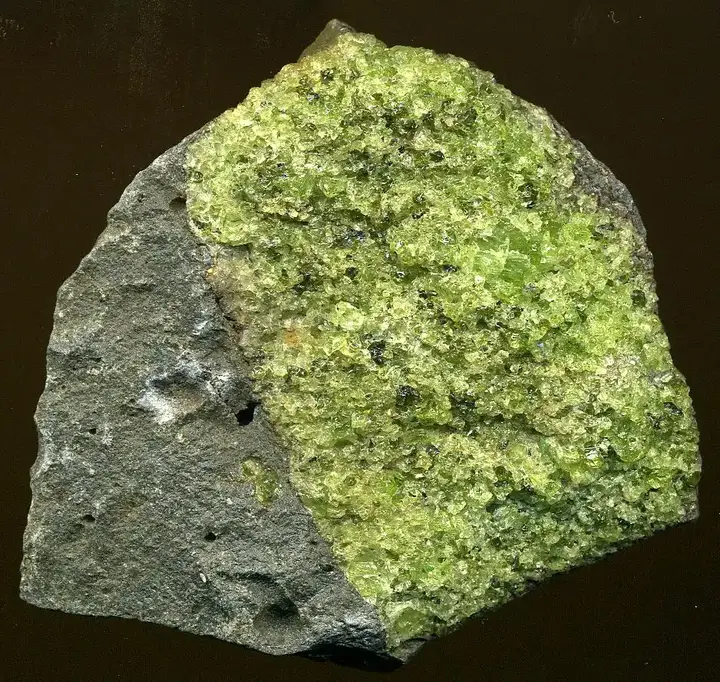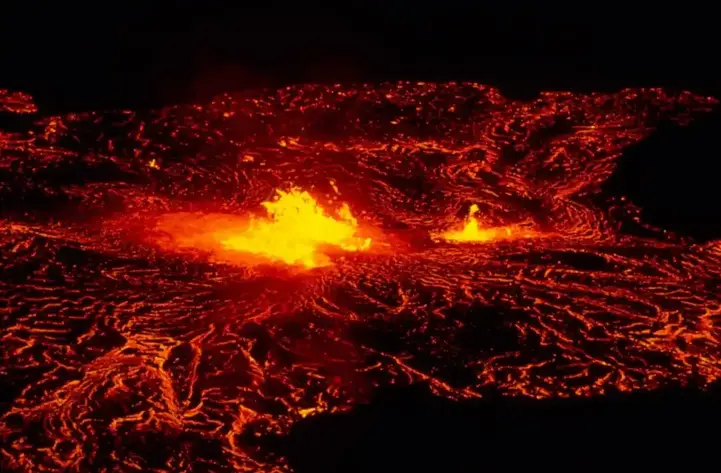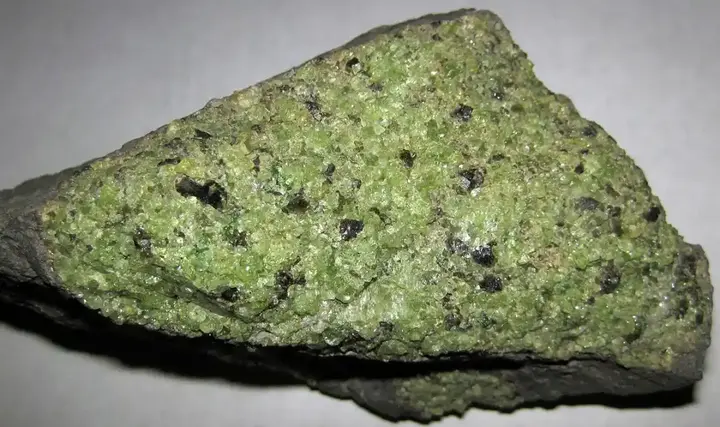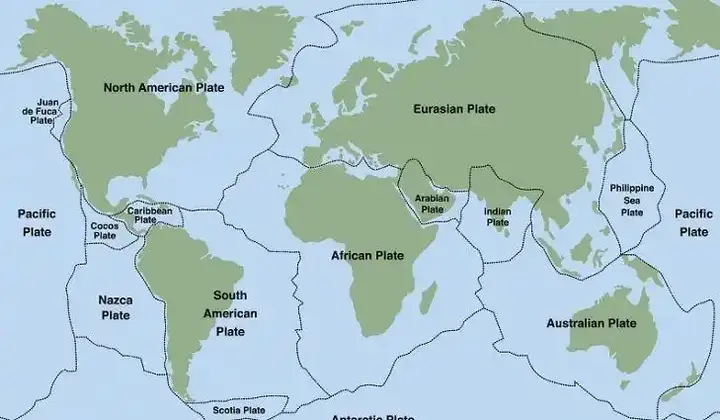Extracting rocks that originated in Earth's mantle may reveal the secrets of the planet's history

The rocks extracted from the mantle are very similar to those that existed on Earth early rather than the more common rocks that make up our continents today, so they are more like time capsules with vital evidence of Earth's history. These rocks, which can be brought to the surface by volcanic activity, tectonic processes or deep-sea drilling, provide a unique window into the processes that have shaped our planet over billions of years. In this article, we show how these rocks reveal the secrets of the Earth's history.
Show key points
- Mantle-derived rocks act as geological time capsules, containing minerals and compositions that have remained largely unchanged since Earth's early history.
- By analyzing their chemical elements and isotopic ratios, scientists can reconstruct the temperature, pressure, and conditions in the mantle at the time these rocks formed.
- These rocks offer critical insights into mantle dynamics and plate tectonics, especially through features like ophiolites, xenoliths, and seismic behavior.
- ADVERTISEMENT
- The study of volcanic rocks such as basalt and kimberlite reveals information about magma origins, mantle composition, and deep Earth processes including diamond formation.
- Mantle rocks contribute to understanding the evolution of Earth's atmosphere and oceans, especially through volcanic gas emissions and the subduction-driven water cycle.
- Variations in the geochemical and isotopic makeup of mantle rocks highlight the mantle's heterogeneity and its role in long-term geochemical cycles.
- Ancient mantle rocks provide clues to early Earth processes like mantle differentiation and crust formation, helping to decode the planet's formative stages.
1- Chemical composition and isotopic signature:

Mantle rocks contain minerals that have not changed relatively since their formation deep underground. By analyzing the chemical composition and isotope ratios in these rocks, scientists can infer mantle conditions over geological time.
Recommend
Chemical composition: The concentration of trace elements, such as rare earth elements, can reveal the degree of partial melting that occurred in the mantle, which in turn can tell us about the temperature, pressure, and composition of the mantle at the time of rock formation.
Isotopic dating: Techniques such as radiometric dating of isotopes in mantle rocks can determine the age of a rock, and then the timing of certain events in Earth's history, such as volcanic eruptions, continental faults, and oceanic crust formation.
2- Mantle dynamics and plate tectonics:

Mantle rocks provide direct evidence of the processes that move plate tectonics and mantle convection:
Ophyolites: These are sections of the oceanic crust and upper mantle that were pushed into the continental crust, often through tectonic processes. The study of ophiolites helps geologists understand the structure and composition of the oceanic lithosphere.
Xenolith: Fragments of mantle rock brought to the surface by volcanic eruptions can provide a picture of the current state of the mantle under certain areas. These xenolyths help understand the temperature, pressure, and composition of the mantle, and how it differs in different tectonic environments.
Seismic studies: Studying how seismic waves travel through different types of mantle rocks allows scientists to map the Earth's internal structure, including the discovery of infiltrated plates, mantle plumes, and other features important for understanding tectonic plates.
3- Volcanoes and magmatic processes:

Mantle rocks are directly related to volcanic activity, which played an important role in shaping the Earth's surface and atmosphere.
Basaltic magma: These rocks arise from the partial melting of the mantle and form the basis of the oceanic crust. By studying the composition of basalt, geologists can deduce the composition of the mantle source zone and the conditions in which the melting occurred. This information helps reconstruct the history of volcanic activity and the evolution of the Earth's crust.
Kimberlite: These are volcanic rocks originating deep inside the mantle and can carry diamonds and other high-pressure minerals to the surface. The Kimberlet study provides insights into deep ground processes, the thermal state of the mantle, and the conditions required for diamond formation.
4- Evolution of the atmosphere and oceans:

Mantle rocks can also provide clues to the evolution of the atmosphere and oceans.
Gas release: Volcanic eruptions, which carry mantle-derived materials to the surface, have played a major role in releasing gases for volatile compounds such as water vapor, carbon dioxide and sulfur dioxide. These gases were crucial in shaping the Earth's early atmosphere and oceans. By studying ancient rocks derived from the mantle, scientists can estimate the composition of volcanic gases emitted in the past and their impact on climate and the environment.
Moisturizing the mantle: Some mantle rocks contain minerals formed by the presence of water, suggesting that water has been circulating between and within the Earth's surface for billions of years. This process, known as subduction, involves transporting water to the mantle via tectonic plates. The study of mantle rocks helps scientists understand the role of water in mantle processes and their impact on mantle dynamics, magma, and Earth's long-term climate.
5- Geochemical tanks and mantle heterogeneity:

The mantle is not a homogeneous layer; it contains distinctive geochemical reservoirs that have evolved over time.
Mantle columns: Scarf rocks can provide evidence of mantle columns, which are hot floating rocks that originate from the depths of the mantle and rise toward the surface. It is believed that these columns are responsible for creating hot spots and large fiery interruptions. By studying the isotope and chemical composition of mantle-derived rocks associated with these features, scientists can trace the origins of mantle plumes and their role in mantle convection and heat distribution within the Earth.
Heterogeneity: Mantle-derived rocks often exhibit chemical and isotopic differences that reflect the complex history of the mantle. These differences can be due to processes such as mantle melting, mixing and recycling of the shell and oceanic sediment. Understanding this diversity helps scientists compile the history of convection in the mantle and the extensive geochemical cycles that influenced the evolution of the Earth.
6- Insights into early Earth operations:

Some of the oldest rocks on Earth, originating from the mantle, provide valuable information about the conditions and processes of the early Earth.
Ancient mantle rocks: These rocks, dating back more than 2.5 billion years, offer a glimpse into the early mantle and its role in early crust formation. By studying these rocks, scientists can infer temperature, pressure, early mantle formation and how it contributed to the formation of the first continental crust.
Mantle Differentiation: The Earth's mantle underwent significant differentiation over time, resulting in the formation of the shell, core and distinctive mantle tanks. Mantle-derived rocks contain evidence of these differentiation processes, helping scientists understand the timing and mechanisms that shaped Earth's internal structure.
The end:

Rocks derived from the mantle are invaluable to our understanding of Earth's history; through their chemical composition, isotopic signatures, and the geological processes they represent, they reveal the dynamic processes that have shaped our planet over billions of years. From the formation of the earth's crust to the evolution of the atmosphere and oceans, mantle rocks provide a deep perspective of time that is critical to reconstructing the complex history of our planet. As we continue to study these rocks, we reveal more secrets about Earth's past, present, and future, providing insights necessary to understanding the planet we call home.
![]()
The Unity Economy: How Isolation Changes Our Buying Habits
Loneliness is becoming a social epidemic, affecting both young and old. Despite being more connected than ever, people feel increasingly isolated, often turning to consumerism for comfort—buying entertainment, luxury, or even companionship. Brands must respond by offering personalization and building communities that help people feel seen and included. more- ADVERTISEMENT
![]()
Is time travel possible? Astrophysicist explains the science behind science fiction
Time travel fascinates us, but science says it’s not so easy. While Einstein’s theory shows time moves differently at high speeds—like for astronauts—true time travel still faces big hurdles. Wormholes, paradoxes, and the laws of physics keep it in the realm of imagination, at least for now. more- ADVERTISEMENT
![]()
Traditional Syrian Glass Blowing : A Timeless Craft
Traditional Syrian Glass Blowing : A Timeless Craft more- ADVERTISEMENT
![]()
Bermuda Triangle Puzzle
The Bermuda Triangle remains a thrilling mystery filled with tales of vanishing ships, eerie time loss, and ghostly weather. Despite scientific theories and advanced research, the true cause of these disappearances continues to puzzle and intrigue the world. more- ADVERTISEMENT
![]()
Sama Beirut... Unique skyscraper
Sama Beirut, Lebanon’s tallest tower, rises with elegance in Achrafieh, offering stunning sea and mountain views. Built by Fadi Antonios out of love for his homeland, it blends green space, luxury living, and modern safety features—all in one iconic landmark symbolizing hope and resilience. more- ADVERTISEMENT
![]()
5 financial habits to improve your finances better than 99% of people
Pay yourself first, spend less than you earn, and avoid emotional decisions—these simple habits can boost your financial health and set you apart. Small steps like saving 10% of your income and thinking before spending pave the way toward lasting financial stability and a more secure, stress-free future. more- ADVERTISEMENT
![]()
Al-Ayjah Lighthouse and Castle in the city of Sur in the Sultanate of Oman
With its stunning coastal views and iconic Al-Ayjah Lighthouse, Tyre—also known as Sur—stands as one of Oman’s oldest and most captivating cities. Rich in maritime history, this ancient port once welcomed over 150 ships daily, bridging trade between continents and continuing to shine through its timeless heritage. more- ADVERTISEMENT
![]()
How to develop your self-confidence?: The journey of character building and self-development
Self-confidence is a powerful inner force that grows through experience, reflection, and personal development. It's not inherited but built over time. With positive thinking, healthy habits, and clear goals, anyone can strengthen their self-worth and face life with courage and resilience. more- ADVERTISEMENT
![]()
Success Guide - How to discover your passion?
Discovering your passion is a personal journey that brings meaning and joy to life. It’s about finding what excites you, motivates you, and makes you feel alive. With patience, reflection, and trying new experiences, you can uncover what truly inspires you without needing to spend a fortune. more- ADVERTISEMENT
![]()
Why does my mood change when I'm hungry?
Feeling hungry can mess with your mood—fatigue, anger, confusion—all thanks to low glucose. As levels drop, stress hormones like cortisol and adrenaline kick in, making you irritable. Even fish get aggressive when hungry! So grab a healthy snack, keep calm, and maybe save your relationships along the way. more- ADVERTISEMENT





















